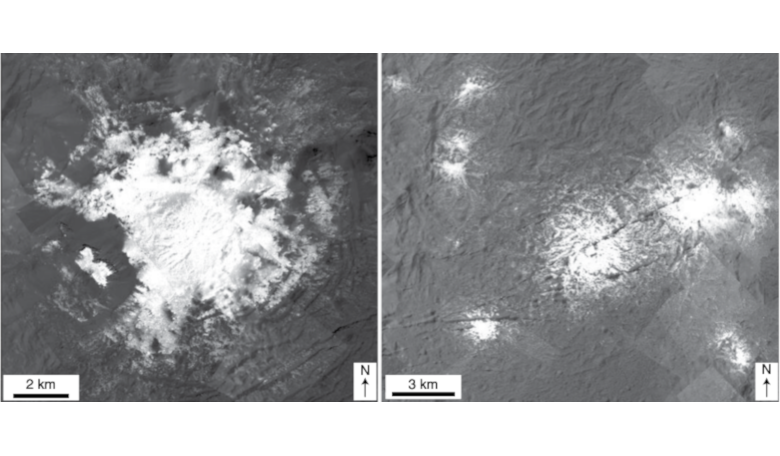Ceres, the largest known asteroid belt object, is, like Pluto before it, helping redefine what a dwarf planet looks like as new observations from the second extended Dawn mission suggests that the rocky-icy body is an ocean world and may have been geologically active in the recent past.
When NASA’s robotic spacecraft, Dawn, took a close interest in the heavily crated world of Ceres between 2015 - 2018, scientists were surprised to see over 300 mysterious bright spots strewn across the icy surface
These white patches turned out to be salt deposits primarily as sodium carbonate and their widespread nature prompted scientists to theorise that subsurface fluid activity was responsible for transporting the salts to Ceres’ surface.
The leading explanation at the time for how briny liquid water was sloshing around below Ceres’ surface was put down to an impact with a large object.
This collision, which carved out a 92 kilometre-wide (57 mile-wide) crater known as Occator - the region where the most prominent bright spots were found – warmed the area and an upsurge of briny water was driven to the surface by a small amount of gas such as water vapour, methane or ammonia.
Fast forward a few years and the theory has now expanded. In a series of seven papers published this week in Nature Astronomy, Nature Geoscience and Nature Communications, teams from around the globe have been working on data sent back by Dawn before it finally exhausted all of its hydrazine fuel, thus ending its mission just under two years ago.
One of the studies, conducted by Carol Raymond and colleagues now suggest that those subsurface briny waters actually run deep, really deep.
Using new high-resolution gravity data and imaging from Dawn to model the region surrounding Occator crater, Raymond, who is based at NASA’s Jet Propulsion Laboratory, found that there is evidence to support an extensive brine reservoir that could stretch around the dwarf planet.
Helping to cement the hypothesis is the new detection of a compound called hydrohalite (NaCl.2H2O). Hydrohalite is very common in marine ice on Earth, but this is the first time that it has been detected beyond our planet.
This hydrated sodium chloride mineral forms from salty water below the freezing temperature of pure water and scientists have found it at Cerealia Facula, a prominent site at the centre of Occator crater.
Discovered by Maria Cristina De Sanctis at the Istituto Nazionale di Astrofisica, Rome, and colleagues, the team says that the material is unstable on Ceres’s surface, so it must have made its way to the surface very recently.
Since impact heat dissipated long ago, recently exposed material had to be sourced from a deeper brine. This suggests that the brines may still be ascending, indicating that salty fluids could still exist in the interior of the dwarf planet says De Sanctis and colleagues.
Meanwhile, back on land, an analysis of Ceres’ crust and mantle by Andreas Nathues and colleagues suggest that Ceres underwent a period of cryovolcanic activity starting around nine million years ago, and persisted until very recently.
Nathues, who used high-resolution images of the Dawn Framing Camera obtained close to the end of the mission, found several resurfacing events that occurred millions of years after crater formation.
Like the other studies connected to this research have indicated, with impact-generated heat long gone by this point the most likely culprit is a deep-seated brine source, in which the salts play a major role in preserving liquid in this heat-starved body, say the team.
Ceres’ ocean is very different from Europa’s or Enceladus’s, but just how habitable this ocean could be or what stage it is at is still unknown. However the outlook doesn’t look particularly good.
“High-resolution gravity data obtained during Dawn’s extended mission revealed an abundance of dense material — that is, salts and rock particles — in the lower crust of Ceres, suggesting that material is reaching saturation in the ocean and is being incorporated in the crust upon freezing,” says Julie Castillo-Rogez also at JPL.
As such, Ceres’ ocean could be nearing the end of its life.
Still, there are many unknowns when it comes to ocean worlds especially ones under low-gravity conditions like Ceres. What is needed, says Castillo-Rogez, is a follow-up mission to help ascertain how the sub-planet evolved.
“The next ten years of dwarf planet exploration requires focus to be brought onto habitability through time in these evolved oceans, which are likely to be rich in organic matter,” Castillo-Rogez explains.
“Until the next mission to Ceres appears on the horizon, scientists need to continue exploring Ceres through the Dawn data and fundamental research, an endeavour that will benefit ocean world science as a whole.”











